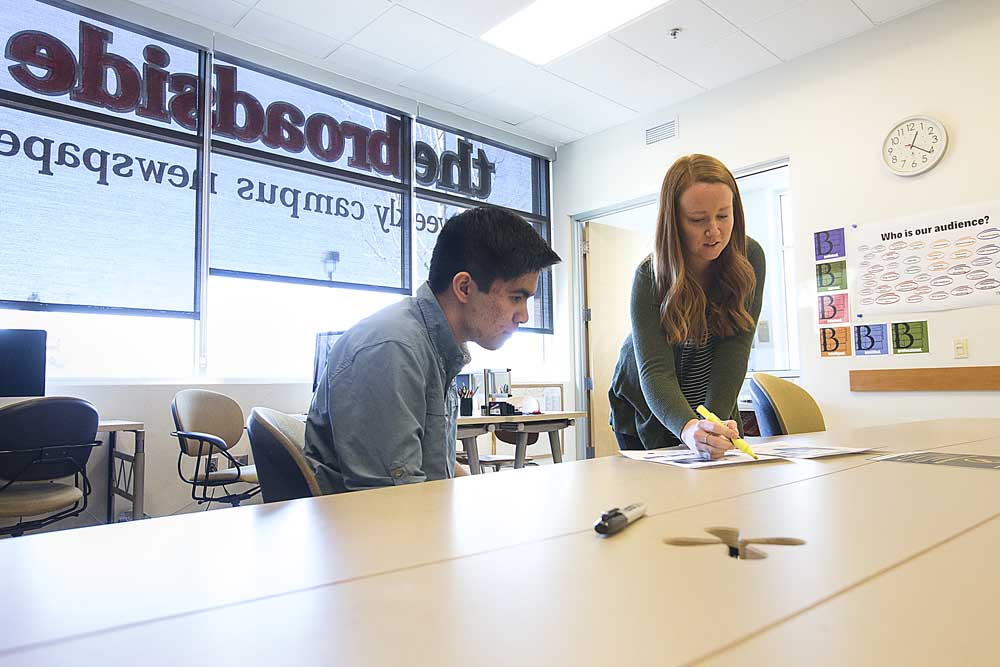Reborn COCC student newspaper tries to attract new audience
Published 5:00 am Friday, March 6, 2020

- Teresa Ristow, student adviser at The Broadside newspaper, discusses with engagement editor Luke Reynolds, 19, ways to place ads throughout the newspaper's website during a meeting in the newsroom at Central Oregon Community College on Wednesday, March 4, 2020.
In its weekly Tuesday meeting, the small staff of The Broadside — Central Oregon Community College’s student newspaper — was brainstorming solutions to a problem many newspapers struggle with: attracting new, young readers.
Engagement editor Luke Reynolds, 19, mentioned that handing out free pizza to students was previously successful in grabbing attention.
He suggested another pizza giveaway, with a catch — students have to prove they follow The Broadside on Twitter or Instagram before getting a slice.
Attracting readers is a good problem to have for The Broadside, which returned in January in an online-only format after the 65-year-old paper was temporarily shut down in 2018.
But even though there are only two people on the staff, editor-in-chief Emma Evenhus, 20, Reynolds and their adviser, Teresa Ristow, are optimistic The Broadside will become a relevant force on COCC’s campuses again, with more students expected to sign up as reporters and unique strategies for getting people to read stories.
“I don’t feel like any of us have gotten really discouraged, which I feel like should have happened by now,” Evenhus said.
To bring back the newspaper, COCC paid Ristow a part-time salary of $19,830. The college also set aside about $38,000 in student fees for student journalist salaries, developing the website and more, according to Andrew Davis, COCC’s director of student campus life.
Ristow spent the fall term getting everything set up for The Broadside’s return in January, she said. That included ordering new computers, recruiting new staff members and even mundane things like resetting passwords that nobody remembered after laying dormant for over a year.
“Having it go away for a year created a ton of challenges,” Ristow said. “No one had saved all the information.”
Ristow was previously a newspaper reporter for about six years in Medford and two Colorado towns before arriving in Bend. Along with advising The Broadside, she’s the managing editor for Oregon Media, which prints Bend Magazine and other guides and newspapers.
When Evenhus first arrived at COCC in 2018, a professor recommended that she write for The Broadside. But it no longer existed.
So Evenhus jumped at the chance to join the paper once it was resurrected.
“I heard that it was coming back, so I joined right away,” she said.
Reynolds, the engagement editor, wanted to dive into journalism partly because the world landscape was “chaotic,” he said.
“The news is more important now than ever, and I think more people now should care about it and be involved in it,” he said.
Because of its small staff, The Broadside doesn’t publish many articles yet. There are a few student freelancers who occasionally contribute, but typically, only one story appears on the website per week, Evenhus said. The topics have ranged from quirky campus stories, to hard COCC news, to coronavirus updates.
But next semester, the paper is expecting an influx of new staff. Five new students have signed up for COCC’s Publication Lab course, which is required for all Broadside staff members, in the spring term. Although students in the course don’t have to join The Broadside staff, it’s heavily encouraged, Ristow said.
And Ristow is taking a big swing to get more student eyeballs on Broadside articles: big touch-screen display kiosks.
The 5.5-feet-tall kiosks — similar to what you’d see in a shopping mall and which cost about $2,100 each — would be paid for with the savings from not physically printing The Broadside, Ristow said. They’d be placed in the busiest parts of COCC’s Bend campus, branded with The Broadside’s logo, and their screens would be permanently displayed on the newspaper’s website. If successful, the kiosks might appear in COCC’s Redmond, Madras and Prineville campuses as well, she said.
“More and more in the news business we see that the information has to come to the readers, versus the readers seeking it out,” Ristow wrote in an email. “So this could be an opportunity to introduce The Broadside to students and other readers in a way that’s low effort for them.”
But even without the giant kiosks, Evenhus said student awareness of The Broadside’s second coming is growing.
“The first time I went to the club fair and talked to a bunch of students, no one really knew what (the Broadside) was,” she said. “But Luke and I set up a table a few weeks ago, and we had students passing through who would say, ‘Oh yeah, I’ve heard about that.’ It’s working!”
Editor’s note: This article has been corrected. The original version misstated Teresa Ristow’s salary. The Bulletin regrets the error.






